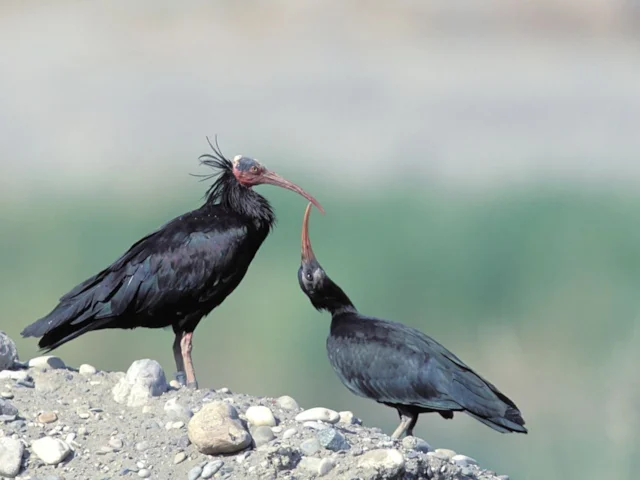Moroccan bald ibises on the up again
adb72553-7646-4c3f-b5a6-cdc16aa8f3f6

The largest fully wild population of the Critically Endangered Northern Bald Ibis is in Morocco, and has had its second most successful breeding season ever this year.
The number of breeding pairs at Souss-Massa National Park and nearby Tamri in south-west Morocco are at their highest since surveys began in the 1980s. The colonies fledged 148 young, bringing the total population at the end of the breeding season to 443 birds.
Once widespread in North Africa and Europe, Northern Bald Ibis survives in two disjunct populations. Well to the east of the Moroccan birds is the semi-captive population at Birecik in Turkey, and south of that a tiny remnant population at Palmyra, Syria. A reintroduced colony in Cadiz province, Spain, has also had some recent successes, but is not yet believed to be self-sustainable.
Management and conservation of the Moroccan population is supervised by SEO/BirdLife (BirdLife in Spain) in conjunction with High Commission for Water and Forest and Fight against desertification and GREPOM (BirdLife in Morocco). SEO/BirdLife has hired seven wardens to protect and monitor the colonies, with funding from HSH Prince Albert II of Morocco, the designated Species Champion, through the BirdLife Preventing Extinctions Programme. The wardens provide daily fresh water for the birds and prevent disturbance. This year they succeeded in persuading a persistent group of anglers to move away from one sub-colony in the national park, allowing the ibises to begin nesting.
The Tamri colony commenced breeding in early February. In contrast to 2012, when breeding at Tamri failed completely, possibly because of low rainfall, 60 pairs fledged 71 young. In Souss Massa National Park breeding did not begin until the first week of March. One sub-colony of six pairs was prevented from nesting by a Lanner Falcon which flew so regularly over the nest ledge that the birds abandoned it. The remaining 53 pairs produced 77 fledglings.
The success may be partly due to better weather improving prey availability, including 200 mm of rainfall between September 2012 and April 2013. “Our monitoring shows that the Northern Bald Ibis population at Souss-Massa contains the largest number of breeding pairs recorded since conservation of this species began in 1993, and certainly since the first surveys of the species in the early 1980s,” said SEO/BirdLife’s Jorge Fernández Orueta. “Only in 2004 was the number of fledged young higher, and if it were not for the territorial behaviour of the Lanner Falcon, this year would probably have exceeded it.”
The number of breeding pairs at Souss-Massa National Park and nearby Tamri in south-west Morocco are at their highest since surveys began in the 1980s. The colonies fledged 148 young, bringing the total population at the end of the breeding season to 443 birds.
Once widespread in North Africa and Europe, Northern Bald Ibis survives in two disjunct populations. Well to the east of the Moroccan birds is the semi-captive population at Birecik in Turkey, and south of that a tiny remnant population at Palmyra, Syria. A reintroduced colony in Cadiz province, Spain, has also had some recent successes, but is not yet believed to be self-sustainable.
Management and conservation of the Moroccan population is supervised by SEO/BirdLife (BirdLife in Spain) in conjunction with High Commission for Water and Forest and Fight against desertification and GREPOM (BirdLife in Morocco). SEO/BirdLife has hired seven wardens to protect and monitor the colonies, with funding from HSH Prince Albert II of Morocco, the designated Species Champion, through the BirdLife Preventing Extinctions Programme. The wardens provide daily fresh water for the birds and prevent disturbance. This year they succeeded in persuading a persistent group of anglers to move away from one sub-colony in the national park, allowing the ibises to begin nesting.
The Tamri colony commenced breeding in early February. In contrast to 2012, when breeding at Tamri failed completely, possibly because of low rainfall, 60 pairs fledged 71 young. In Souss Massa National Park breeding did not begin until the first week of March. One sub-colony of six pairs was prevented from nesting by a Lanner Falcon which flew so regularly over the nest ledge that the birds abandoned it. The remaining 53 pairs produced 77 fledglings.
The success may be partly due to better weather improving prey availability, including 200 mm of rainfall between September 2012 and April 2013. “Our monitoring shows that the Northern Bald Ibis population at Souss-Massa contains the largest number of breeding pairs recorded since conservation of this species began in 1993, and certainly since the first surveys of the species in the early 1980s,” said SEO/BirdLife’s Jorge Fernández Orueta. “Only in 2004 was the number of fledged young higher, and if it were not for the territorial behaviour of the Lanner Falcon, this year would probably have exceeded it.”

